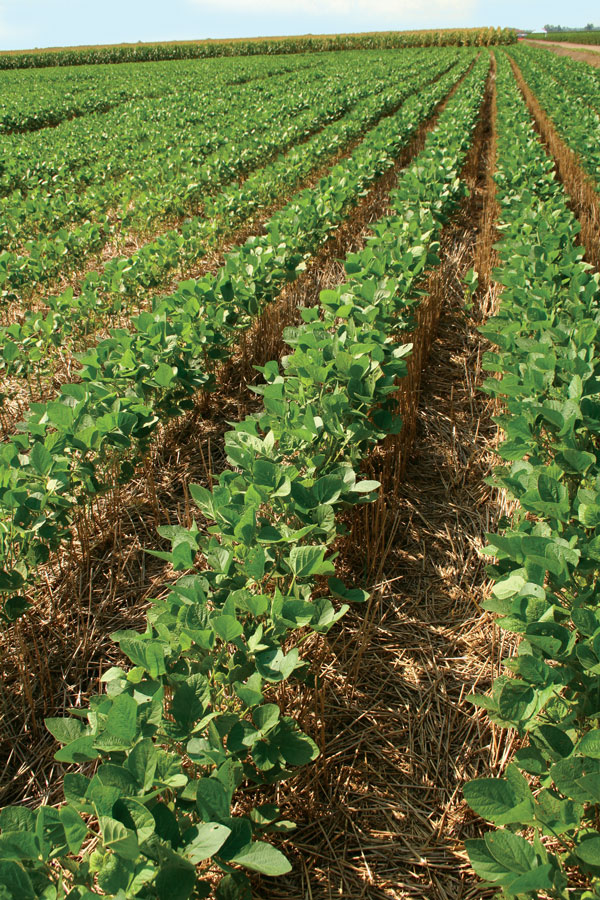January 17, 2014

With more than half the soybeans in the upper Southeast planted double-crop in 2013, many growers are planning how they can avoid a repeat performance this year of the rain-plagued, late-planted conventional and double-crop beans they dealt with last season.
In much of the Carolinas and some parts of Virginia, conventional soybeans were pushed back by unusually heavy rainfall and uncharacteristically cool, damp weather.
A bigger problem was caused by delays in getting wheat harvested and planting double-crop beans. Whether beans planted in July will make it to maturity before the first frost is always a gamble.
Regardless of the uncertainties, growers need to plan ahead on what they will do with this year’s soybean crop.
Veteran Virginia Tech Soybean Specialist David Holshouser contends one thing they need to take a close look at is the system they use to plant soybeans. Historically, growers have used what record-breaking Missouri soybean grower Kip Cullers calls “a controlled spill.”
“My biggest problem with that approach is that we don’t really know how ‘controlled’ the spill might be,” Holshouser says. He notes that many years of plot research and on-farm testing have proven to him that narrow rows will increase yield. More specifically, he contends, uniform stands obtained with precision planters — especially in narrow-row plantings and in double-crop beans behind winter grain — will increase soybean yield.
Traditionally, growers overlook gaps in soybean rows because soybeans have a well-documented ability to fill in the gaps. Plants will produce branches and foliage to fill the gaps — but not completely, he says.
“For a lot of years, I’ve walked through fields in which soybeans were planted with a conventional drill and seen gaps in the rows. For one thing, that indicates a lack of crop competition with weeds, whether beans are conventional or double-crop.”
When yield monitors first became popular, growers began to more closely see how much yield they were losing to weeds competing with soybeans for light and nutrients. In many cases, the weeds emerged late within the gaps left by the drill. Obviously, the better the weed control, the less competition and the less impact on yield.
Weed control — good weed control — in soybeans can be expensive, and in growing seasons like 2013, weeds can get away from even the most careful grower. Preventing gaps within the row will improve weed control and keep expenses down.
Less obvious, but likely as damaging to soybean yields, are clumps of soybean plants and subsequent skips between them. The question then becomes: Is the plant meeting leaf area requirements?
Holshouser stresses that the soybean canopy needs to be fully formed before plants start to flower in order to maximize yields. When there are gaps in the rows, canopy closure doesn’t occur.
“I want to see soybeans pop out of the ground quickly, especially in a double-crop situation, and be weed-free,” he says.
“If that happens, plants can capture a maximum amount of sunlight in their early growth stages, and the canopy can form as it needs to do to insure maximum plant growth.”
In April- and May-planted soybeans, this may not be as big a problem. However, anytime there are four to five plants in an area where one to two should be, those extra plants become weeds that compete for moisture and nutrients — and yields are hurt.
“In late-planted soybeans, especially in late-planted double-crop beans, gaps in rows of soybeans will hurt yield,” Holshouser says. “However, this yield loss may also happen in fields with high yield potential that were conventionally planted.”
Over more than 10 years of testing soybeans at the Tidewater Agriculture Research Station in Suffolk, Va., he says he consistently saw a 10 percent to 20 percent yield increase by shifting from 15-inch to 18-inch row spacings down to 7.5-inch or 9-inch row spacings.
“It didn’t always happen, but it was consistent enough to convince me that narrow rows are better,” he says. “The surprising thing was that I couldn’t duplicate the small plot research findings when I did the same thing on a bigger scale with farmers.”
During that time, the Precision Seeding System, a Great Plains grain drill, came on the market. It had a standard drill equipped with an accurate metering system placed close to the row, and did not have the long seed tubes common to planters of that time.
“This planter did its job,” Holshouser says. “In tests in the Northern Neck of Virginia, a big grain-producing area of the state, we got some of the most uniform soybean fields I’ve ever seen. We got a shorter, more uniform crop canopy than we did with a standard 7.5-inch drill.
“In a double-crop situation using the precision drill versus a 15-inch Kinze vacuum planter, we got a better yield in that series of on-farm tests two years out of three, and comparable yields the third year of the tests.
“By contrast, when we compared the 15-inch Kinze planter with a conventional drill, yields were equal three of four years. In one of those years, the 15-inch planter actually out-yielded the conventional drill.
“The take-home message from this research was that we can increase yields by moving from 15-inch rows to 7.5-inch rows — but only if we meter out the seed to give uniform stands within the row.
Getting soybean seed planted precisely, and getting uniform growth, without skips in the row, may not pay off every year under every situation. But in most years, and certainly in 2013, uniform rows paid off for growers.”
See more articles from the Southern Corn and Soybean Production Guide!
About the Author(s)
You May Also Like






